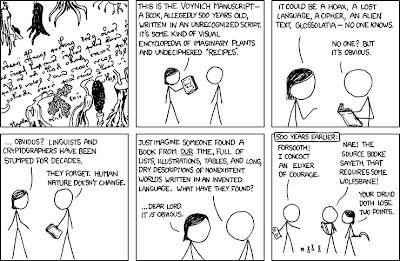
A Canticle for Leibowitz, by Walter M. Miller, published 1960. Considered one of the classics of apocalyptic fiction, it focuses on the abbey of Saint Leibowitz 600 years after the Third World War. The novel continues to two more settings, hundreds of years in the future, but the most compelling part of the book is the first chapter. Picture the monks in the abbey conserving what little remains of pre-war knowledge, copying blueprints, memos, conversation logs and other random data labourously by hand. Essential apocalypse reading.
Brother Francis Gerard of Utah might never have discovered the blessed documents, had it not been for the pilgrim with girded loins who appeared during that young novice's Lenten fast in the desert.
Never before had Brother Francis actually seen a pilgrim with girded loins, but that this one was the bona fide article he was convinced as soon as he had recovered from the spine-chilling effect of the pilgrim's advent on the far horizon, as a wiggling iota of black caught in a shimmering haze of heat. Legless, but wearing a tiny head, the iota materialized out of the mirror glaze on the broken roadway and seemed more to writhe than to walk into view, causing Brother Francis to clutch at the crucifix of his rosary and mutter an Ave or two. The iota suggested a tiny apparition spawned by the heat demons who tortured the land at high noon, when any creature capable of motion on the desert (except the buzzards and a few monastic hermits such as Francis) lay motionless in its burrow or hid beneath a rock from the ferocity of the sun. Only a thing monstrous, a thing preternatural, or a thing with addled wits would hike purposefully down the trail at noon this way.
Brother Francis added a hasty prayer to Saint Raul the Cyclopean, patron of the misborn, for protection against the Saint's unhappy proteges.
Read the first chapter of A Canticle for Leibowitz




.jpg)


